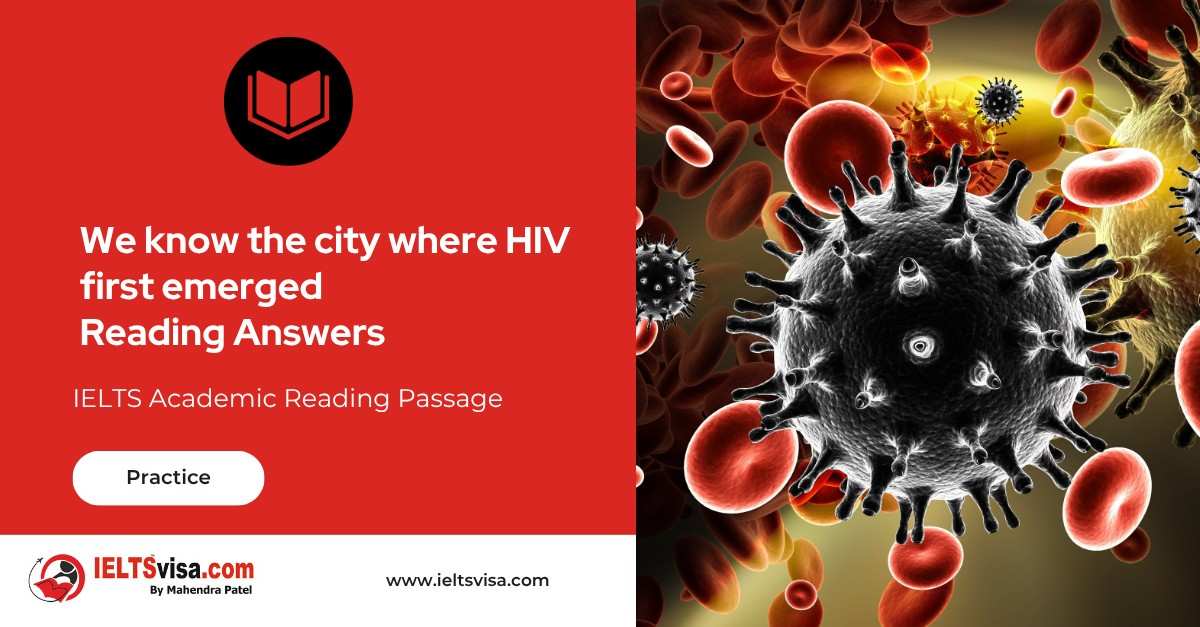We know the city where HIV first emerged Reading Answers
IELTS Academic Reading Passage
It is easy to see why AIDS seemed so mysterious and frightening when US medics first encountered it 35 years ago. The condition robbed young, healthy people of their strong immune system, leaving them weak and vulnerable. And it seemed to come out of nowhere.
Today we know much more how and why HIV – the virus that leads to AIDS – has become a global pandemic. Unsurprisingly, sex workers unwittingly played a part. But no less important were the roles of trade, the collapse of colonialism, and 20th Century sociopolitical reform.
HIV did not really appear out of nowhere, of course. It probably began as a virus affecting monkeys and apes in west central Africa.
From there it jumped species into humans on several occasions, perhaps because people ate infected bushmeat. Some people carry a version of HIV closely related to that seen in sooty mangabey monkeys, for instance. But HIV that came from monkeys has not become a global problem.
We are more closely related to apes, like gorillas and chimpanzees, than we are to monkeys. But even when HIV has passed into human populations from these apes, it has not necessarily turned into a widespread health issue.
HIV originating from apes typically belongs to a type of virus called HIV-1. One is called HIV-1 group O, and human cases are largely confined to west Africa.
In fact, only one form of HIV has spread far and wide after jumping to humans. This version, which probably originated from chimpanzees, is called HIV-1 group M (for “major”). More than 90% of HIV infections belong in group M. Which raises an obvious question: what’s so special about HIV-1 group M?
A study published in 2014 suggests a surprising answer: there might be nothing particularly special about group M.
It is not especially infectious, as you might expect. Instead, it seems that this form of HIV simply took advantage of events. “Ecological rather than evolutionary factors drove its rapid spread,” says Nuno Faria at the University of Oxford in the UK.
Faria and his colleagues built a family tree of HIV, by looking at a diverse array of HIV genomes collected from about 800 infected people from central Africa.
Genomes pick up new mutations at a fairly steady rate, so by comparing two genome sequences and counting the differences they could work out when the two last shared a common ancestor. This technique is widely used, for example to establish that our common ancestor with chimpanzees lived at least 7 million years ago.
“RNA viruses such as HIV evolve approximately 1 million times faster than human DNA,” says Faria. This means the HIV “molecular clock” ticks very fast indeed.
It ticks so fast, Faria and his colleagues found that the HIV genomes all shared a common ancestor that existed no more than 100 years ago. The HIV-1 group M pandemic probably first began in the 1920s.
Then the team went further. Because they knew where each of the HIV samples had been collected, they could place the origin of the pandemic in a specific city: Kinshasa, now the capital of the Democratic Republic of Congo.
At this point, the researchers changed tack. They turned to historical records to work out why HIV infections in an African city in the 1920s could ultimately spark a pandemic.
A likely sequence of events quickly became obvious. In the 1920s, DR Congo was a Belgian colony and Kinshasa – then known as Leopoldville – had just been made the capital. The city became a very attractive destination for young working men seeking their fortunes, and for sex workers only too willing to help them spend their earnings. The virus spread quickly through the population.
It did not remain confined to the city. The researchers discovered that the capital of the Belgian Congo was, in the 1920s, one of the best connected cities in Africa. Taking full advantage of an extensive rail network used by hundreds of thousands of people each year, the virus spread to cities 900 miles (1500km) away in just 20 years.
Everything was in place for an explosion in infection rates in the 1960s.The beginning of that decade brought another change.
Belgian Congo gained its independence, and became an attractive source of employment to French speakers elsewhere in the world, including Haiti. When these young Haitians returned home a few years later they took a particular form of HIV-1 group M, called “subtype B”, to the western side of the Atlantic.
It arrived in the US in the 1970s, just as sexual liberation and homophobic attitudes were leading to concentrations of gay men in cosmopolitan cities like New York and San Francisco. Once more, HIV took advantage of the sociopolitical situation to spread quickly through the US and Europe.
“There is no reason to believe that other subtypes would not have spread as quickly as subtype B, given similar ecological circumstances,” says Faria.
The story of the spread of HIV is not over yet.
For instance, in 2015 there was an outbreak in the US state of Indiana, associated with drug injecting.
The US Centers for Disease Control and Prevention has been analyzing the HIV genome sequences and data about location and time of infection, says Yonatan Grad at the Harvard School of Public Health in Boston, Massachusetts. “These data help to understand the extent of the outbreak, and will further help to understand when public health interventions have worked.”
This approach can work for other pathogens. In 2014, Grad and his colleague Marc Lipsitch published an investigation into the spread of drug-resistant gonorrhoea across the US.
“Because we had representative sequences from individuals in different cities at different times and with different sexual orientations, we could show the spread was from the west of the country to the east,” says Lipsitch.
What’s more, they could confirm that the drug-resistant form of gonorrhoea appeared to have circulated predominantly in men who have sex with men. That could prompt increased screening in these at-risk populations, in an effort to reduce further spread.
In other words, there is real power to studying pathogens like HIV and gonorrhoea through the prism of human society.
Questions 13-20
Do the following statements agree with the information given in Reading Passage 1?
In boxes 13-20 on your answer sheet, write
TRUE if the statement agrees with the information
FALSE if the statement contradicts the information
NOT GIVEN if there is no information on this
- AIDS were first encountered 35 years ago. ……………
- The most important role in developing AIDS as a pandemia was played by sex workers ……………
- It is believed that HIV appeared out of nowhere. ……………
- Humans are not closely related to monkey. ……………
- HIV-1 group O originated in 1920s. ……………
- HIV-1 group M has something special. ……………
- Human DNA evolves approximately 1 million times slower than HIV. ……………
- Scientists believe that HIV already existed in 1920s. ……………
Questions 21-28
Complete the sentences below.
Write NO MORE THAN TWO WORDS from the passage for each answer.
Write your answers in boxes 21-28 on your answer sheet.
- Scientists can place the origin of …………… in a specific city.
- Kinshasa was a very …………… for young working men and many others willing to spend their money.
- In just 20 years virus managed to …………… to cities 900 miles away.
- Belgian Congo became an attractive source of employment to French speakers when it gained …………….
- HIV has spread quickly through the US and Europe because of the …………….
- It is said that outbreak in Indiana was associated with …………….
- The same approach as for HIV can work for …………….
- The form of gonorrhoea that is drug-resistant appeared to have …………… in men who have sex with men.

Solution For: We know the city where HIV first emerged
Reading Answers
| 13. True | 14. False |
| 15. False | 16. True |
| 17. Not given | 18. False |
| 19. True | 20. True |
| 21. The pandemic | 22. Attractive destination |
| 23. Spread | 24. Its independence |
| 25. Sociopolitical situation | 26. Drug injecting |
| 27. Other pathogens | 28. Circulated predominantly |
Review and Practice
- Regularly practice with IELTS reading samples and time yourself to get used to the pressure of the exam.
- Review your mistakes to understand where you went wrong and how to avoid similar errors in the future.
Our Books
Master IELTS Speaking Part 1
IELTS Writing Task 1 Book
IELTS Writing Task 2 Book
We know the city where HIV first emerged Reading Answers Explanation
Comin Soon
Practice IELTS Other Modules
IELTS Listening
The IELTS Listening test assesses how well you can understand spoken English in various contexts. It lasts about 30 minutes and is divided into four sections with a total of 40 questions. The listening tasks become increasingly difficult as the test progresses.
IELTS Academic Reading
The IELTS Academic Reading section assesses your ability to understand and interpret a variety of texts in academic settings. It is designed to evaluate a range of reading skills, including skimming for gist, reading for main ideas, reading for detail, understanding inferences, and recognizing a writer's opinions and arguments.
IELTS Speaking
The IELTS Speaking test assesses your ability to communicate in English on everyday topics. It lasts 11-14 minutes and consists of three parts: introduction, cue card, and a discussion based on the cue card topic.
IELTS General Reading
IELTS General Reading tests your ability to understand and interpret various types of texts. Here are some key areas and types of content you can expect to encounter in the reading section, along with tips for effective preparation.
IELTS Academic Writing Task 1
In IELTS Academic Writing Task 1, you are presented with a visual representation of information, such as graphs, charts, tables, or diagrams, and you are required to summarize, compare, or explain the data in your own words.
IELTS General Writing Task 1
In IELTS General Writing Task 1, you are required to write a letter based on a given situation. The letter can be formal, semi-formal, or informal, depending on the prompt. Here’s a breakdown of the key components to include in your letter
IELTS Academic Writing Task 2
In IELTS Academic Writing Task 2, you are required to write an essay in response to a question or topic. Here’s a guide to help you understand the essential elements of this task
IELTS Exam Tips
To succeed in the IELTS exam, practice regularly, familiarize yourself with the test format, improve your vocabulary, develop time management skills, and take mock tests to build confidence.
Grammer for IELTS
Grammar is the foundation of effective communication in English. Understanding tense usage, subject-verb agreement, and sentence structure enhances clarity and coherence in writing and speaking.
Vocabulary for IELTS
Vocabulary plays a crucial role in the IELTS (International English Language Testing System) exam, especially in the Speaking and Writing sections. Here’s an overview of why vocabulary is important and how it impacts your performance
RECENT IELTS SAMPLES QUESTIONS AND ANSWERS
Ebonics Reading Answers
A. Ebonics - also known by a host of other names such as African American Vernacular English,...
A Disaster Of Titanic Proportions
A. At 11:39 p.m. on the evening of Sunday, 14 April 1912, lookouts Frederick Fleet and...
Vitamins To supplement or not?
Mineral, vitamin, and antioxidant health supplements make up a multi-billion-dollar industry...
The Hollywood film industry
A. This chapter examines the ‘Golden Age’ of the Hollywood film studio system and explores how...
Three Dimensional Films Reading Answers
A. In the theatre of the Ambassador Hotel in Los Angeles, on the evening of 27 September 1922,...
The Developing World Reading Answers
A THE DEVELOPING WORLD — the economically underdeveloped countries of Asia. Africa. Oceania...













